 Dogwoods (Cornus spp.) are a diverse group of trees and woody shrubs that are highly regarded for their ornamental value. There are approximately 30- 60 different species of dogwood; the flowering dogwood, (Cornus florida), is one of the most popular. Dogwoods have a diverse range of uses in the landscape from specimen tree to accent shrub. In New England, dogwoods flower in early spring, with most species exhibiting deep red foliage in the fall. The exfoliating bark on Kousa dogwood, showy red bark on red twig dogwood, and horizontal branching on some species help create winter interest. Dogwood lumber has a dense and fine grain at its core giving it excellent shock resistance. which makes it ideal for heavy use items such as tool handles and golf club heads.
Dogwoods (Cornus spp.) are a diverse group of trees and woody shrubs that are highly regarded for their ornamental value. There are approximately 30- 60 different species of dogwood; the flowering dogwood, (Cornus florida), is one of the most popular. Dogwoods have a diverse range of uses in the landscape from specimen tree to accent shrub. In New England, dogwoods flower in early spring, with most species exhibiting deep red foliage in the fall. The exfoliating bark on Kousa dogwood, showy red bark on red twig dogwood, and horizontal branching on some species help create winter interest. Dogwood lumber has a dense and fine grain at its core giving it excellent shock resistance. which makes it ideal for heavy use items such as tool handles and golf club heads.
Growing Conditions
Dogwoods in the wild exist as understory plants that typically grow at the edge of a forested area or on river banks. As a result, some species struggle to acclimate when placed into an open landscape. Dogwoods are tolerant of most growing conditions except for extremely wet or dry soils. They prefer moist, well drained soils, with higher levels of organic material to fill their nutritional requirements. Dogwoods prefer slightly acidic soils within the pH range of 5.5-6.6, which makes them well adapted to most native New England soils. Most species require little to no pruning as they have been bred to have an aesthetically pleasing shape. When planting and maintaining dogwoods the following cultural guidelines should be followed:
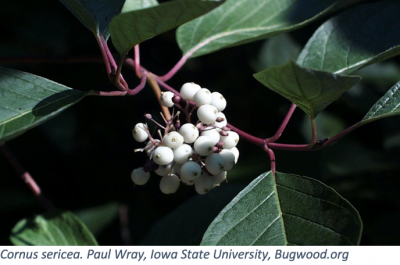 Buy healthy trees.
Buy healthy trees.- Plant in early spring.
- Use proper planting technique.
- Be sure site is well drained.
- Maintain low mulch around the tree.
- Water adequately during dry weather.
- Protect the trunk from mechanical injury.
What’s wrong with my Dogwood?
Pests and Diseases
The decline of dogwood trees and shrubs is a common concern. One or more of the following factors may be involved: environmental stress, fungal disease, or insect infestation. Because of our climate, the state is in the northern fringe of cold hardiness for dogwoods. Any severe change in the environment, such as drought or long periods of high temperature, can stress the plant.
Common causes of dogwood decline in Connecticut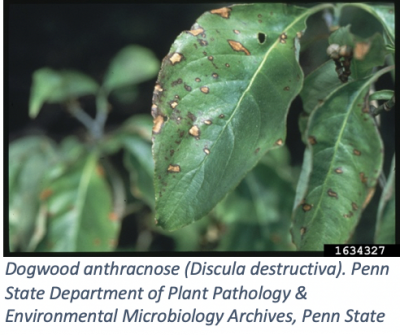
Diseases
- Dogwood anthracnose (Discula spp.) is a fungal disease that produces small 1/8- inch reddish brown spots on the leaves. As the surface area of the spots increases, the spots will often merge with another to cover a quarter or more of the leaf surface.
- Leaf and flower blight (Phytopthora spp.) is a fungus-like disease that causes blighting of leaves and an ash gray appearance on twigs. Small, raised fruiting structures can sometimes be seen on dead twigs. Leaves may become completely blighted and remain attached to the tree over the winter.
- Crown canker or collar rot (Phytophthora spp.)- is a fungus-like disease that gets its
 name from the slow growing canker it produces on the trunk, near the soil line. The bark around this area dies, and a dark colored ooze is emitted from the canker. Infected trees have an overall lack of vigor and produce smaller and fewer leaves that will prematurely drop. Infected trees may also put out a larger bloom than usual with more fruit, and they are prone to showing symptoms of wilt during dry spells in the summer season. Gradual die back of twigs and branches, starting on one side of the tree, will eventually spread to the rest of the tree resulting in death.
name from the slow growing canker it produces on the trunk, near the soil line. The bark around this area dies, and a dark colored ooze is emitted from the canker. Infected trees have an overall lack of vigor and produce smaller and fewer leaves that will prematurely drop. Infected trees may also put out a larger bloom than usual with more fruit, and they are prone to showing symptoms of wilt during dry spells in the summer season. Gradual die back of twigs and branches, starting on one side of the tree, will eventually spread to the rest of the tree resulting in death.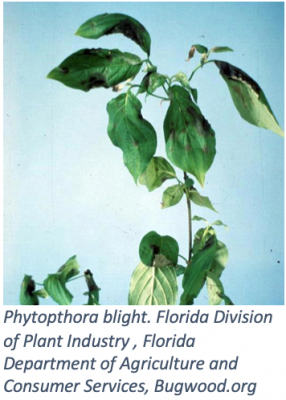
- Botryosphaeria canker and dieback (Botryosphaeria sp.) - can be recognized by its small, black, spore-bearing structures found on the twigs and branches. Infected plants will exhibit sporadic dieback of branches and twigs while other parts of the plant appear healthy. Leaves on affected stems will begin to wilt and curl inward before turning brown. Disease occurrence and severity can be increased by physical damage, drought stress, and heat stress. As cankers grow, they can eventually spread through the wood, eventually girdling the stem.
 Cercospora leaf spot (Cercospora spp.)- is a fungal disease that causes small (1/8-inch) lesions on leaves. The lesions range from tan to light gray and have a dark border. Tiny, black fruiting structures can be seen within the lesions using a hand lens. Lesions can become fuzzy during high humidity conditions.
Cercospora leaf spot (Cercospora spp.)- is a fungal disease that causes small (1/8-inch) lesions on leaves. The lesions range from tan to light gray and have a dark border. Tiny, black fruiting structures can be seen within the lesions using a hand lens. Lesions can become fuzzy during high humidity conditions.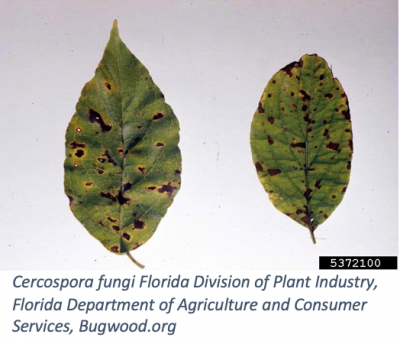
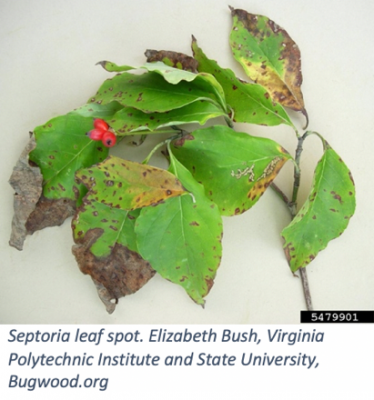
 Septoria leaf spot (Septoria spp.)- This fungal disease causes angular brown lesions on leaf surfaces. Severe cases can cause early leaf drop but is unlikely to cause plant death unless symptoms persist over multiple years. Damage does not spread to twigs or branches making it a less harmful Botryosphaeria canker.
Septoria leaf spot (Septoria spp.)- This fungal disease causes angular brown lesions on leaf surfaces. Severe cases can cause early leaf drop but is unlikely to cause plant death unless symptoms persist over multiple years. Damage does not spread to twigs or branches making it a less harmful Botryosphaeria canker.- Spot anthracnose (Elsinoe cornii)- This fungal disease causes small (1/16-1/18-inch) dark spots with purplish borders on leaf surfaces and flower bracts. Spot anthracnose can be seen on flower bracts and leaves. It is most commonly observed during abnormally wet spring seasons. Plants are often able to grow out of this disease with implementation of proper growing conditions.
 Botrytis blight (Botrytis spp.)- This fungal disease, also known as gray mold, is most commonly seen during cool, rainy weather during spring and fall. Botrytis can be identified by its pronounced gray spores on dead and decaying plant tissue, and it has a fuzzy appearance.
Botrytis blight (Botrytis spp.)- This fungal disease, also known as gray mold, is most commonly seen during cool, rainy weather during spring and fall. Botrytis can be identified by its pronounced gray spores on dead and decaying plant tissue, and it has a fuzzy appearance. Powdery mildew (Microsphaera spp. & Phyllactinia spp.)- Powdery mildew is a fungal disease and can be identified by the powdery white-gray fungal colonies it produces on upper leaf surfaces. Affected leaves will begin to stunt and curl with red or purple discoloration on older leaves. In advanced cases, some leaf scorching has been observed.
Powdery mildew (Microsphaera spp. & Phyllactinia spp.)- Powdery mildew is a fungal disease and can be identified by the powdery white-gray fungal colonies it produces on upper leaf surfaces. Affected leaves will begin to stunt and curl with red or purple discoloration on older leaves. In advanced cases, some leaf scorching has been observed.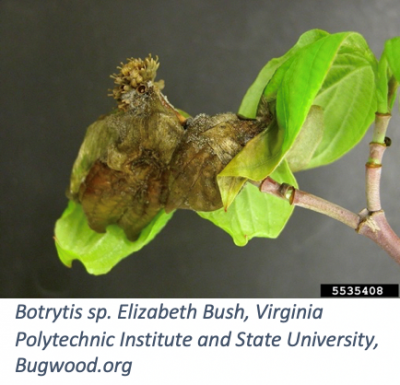
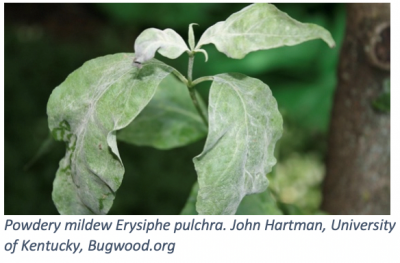
Insects
 Dogwood borer (Synanthedon scitula)- is the most serious insect pest of dogwoods. The dogwood borer makes irregular tunnels under the bark on the main stem and sometimes on the base of limbs. Small trees or branches may be girdled. Young trees are frequently killed, and older ones are reduced in vitality, often leading to death. The adult insect is a clearwing moth which lays eggs from early May to mid-July. Upon hatching, larvae enter the plant through cracks, wounds and fresh scars. Once inside, they disrupt the nutrient supply channels of the tree. Young dogwoods are often attacked at the ground line. Symptoms of the borer attack include drying and dropping of leaves, dieback of branches, the emergence of numerous watersprouts near the borer damage and borer holes on the trunk.
Dogwood borer (Synanthedon scitula)- is the most serious insect pest of dogwoods. The dogwood borer makes irregular tunnels under the bark on the main stem and sometimes on the base of limbs. Small trees or branches may be girdled. Young trees are frequently killed, and older ones are reduced in vitality, often leading to death. The adult insect is a clearwing moth which lays eggs from early May to mid-July. Upon hatching, larvae enter the plant through cracks, wounds and fresh scars. Once inside, they disrupt the nutrient supply channels of the tree. Young dogwoods are often attacked at the ground line. Symptoms of the borer attack include drying and dropping of leaves, dieback of branches, the emergence of numerous watersprouts near the borer damage and borer holes on the trunk. Club gall midge (Resslliella clavula)-This pest is exclusive to flowering dogwood (Cornus florida).
Club gall midge (Resslliella clavula)-This pest is exclusive to flowering dogwood (Cornus florida).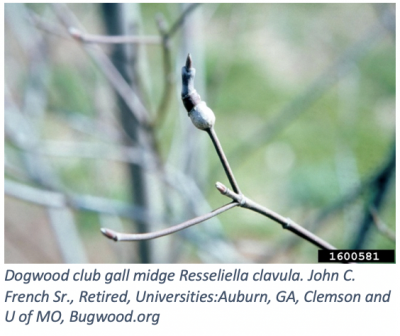 Damage from the club gall midge can be seen in the form of galls that are typically 1/2 – 1-inch in size. The gall will occasionally cause death of plant tissue nearby, and trees may be deformed by heavy
Damage from the club gall midge can be seen in the form of galls that are typically 1/2 – 1-inch in size. The gall will occasionally cause death of plant tissue nearby, and trees may be deformed by heavy
infestations.
Despite good cultural practices, pests and diseases at times may appear. Chemical control should be used only after all other methods have failed. For pesticide information or other questions please call toll free: 877-486-6271.
UConn Home and Garden Education Center, 2020.